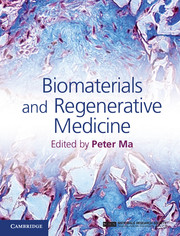Book contents
- Frontmatter
- Contents
- List of contributors
- Preface
- Part I Introduction to stem cells and regenerative medicine
- Part II Porous scaffolds for regenerative medicine
- Part III Hydrogel scaffolds for regenerative medicine
- Part IV Biological factor delivery
- Part V Animal models and clinical applications
- 25 Bone regeneration
- 26 Biomaterials for engineered tendon regeneration
- 27 Advancing articular cartilage repair through tissue engineering: from materials and cells to clinical translation
- 28 Engineering tissue-to-tissue interfaces
- 29 Models of composite bone and soft-tissue limb trauma
- 30 Tooth development and regeneration
- 31 Dentin–pulp tissue engineering and regeneration
- 32 Dental enamel regeneration
- 33 Hair follicle and skin regeneration
- 34 In-vitro blood vessel regeneration
- 35 Stem cells for vascular engineering
- 36 Cardiac tissue regeneration in bioreactors
- 37 Bladder regeneration
- Index
- References
27 - Advancing articular cartilage repair through tissue engineering: from materials and cells to clinical translation
from Part V - Animal models and clinical applications
Published online by Cambridge University Press: 05 February 2015
- Frontmatter
- Contents
- List of contributors
- Preface
- Part I Introduction to stem cells and regenerative medicine
- Part II Porous scaffolds for regenerative medicine
- Part III Hydrogel scaffolds for regenerative medicine
- Part IV Biological factor delivery
- Part V Animal models and clinical applications
- 25 Bone regeneration
- 26 Biomaterials for engineered tendon regeneration
- 27 Advancing articular cartilage repair through tissue engineering: from materials and cells to clinical translation
- 28 Engineering tissue-to-tissue interfaces
- 29 Models of composite bone and soft-tissue limb trauma
- 30 Tooth development and regeneration
- 31 Dentin–pulp tissue engineering and regeneration
- 32 Dental enamel regeneration
- 33 Hair follicle and skin regeneration
- 34 In-vitro blood vessel regeneration
- 35 Stem cells for vascular engineering
- 36 Cardiac tissue regeneration in bioreactors
- 37 Bladder regeneration
- Index
- References
Summary
Introduction
Owing to the inability of cartilage to heal even minor defects, as well as the prevalence of osteoarthritis, the biological repair of this tissue has been the primary focus of decades of basic science and pre-clinical research. This research focussed on cartilage repair has witnessed marked advances via developments in biomaterials science as well as in tissue engineering methodologies. In this chapter, we review select topics in cartilage tissue engineering, describe current clinical cartilage repair procedures, and discuss ongoing considerations relating to the realization of these advances through pre-clinical animal models.
Cartilage
Cartilage is a collagenous, proteoglycan-rich, and water-saturated flexible soft connective tissue. A single cell type, the chondrocyte, is responsible for cartilage tissue maintenance and homeostasis. The tissue is aneural and avascular in the adult and relies on diffusion for nutrient and waste exchange (Brodin, 1955; Strangeways, 1920). The structure and function of cartilage categorizes these soft connective tissues into three broad groupings: elastic cartilage, fibrocartilage, and hyaline cartilage (Gray and Goss, 1973).
- Type
- Chapter
- Information
- Biomaterials and Regenerative Medicine , pp. 488 - 513Publisher: Cambridge University PressPrint publication year: 2014



